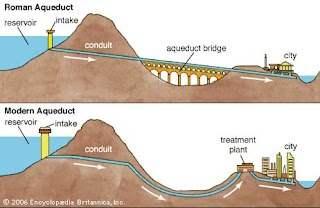An aqueduct is a water supply or navigable channel constructed to convey
water. In modern engineering, the term is used for any system of pipes,
ditches, canals, tunnels, and other structures used for this purpose.
In a more restricted use, aqueduct (occasionally water bridge) applies
to any bridge or viaduct that transports water - instead of a path, road
or railway - across a gap. Large navigable aqueducts are used as
transport links for boats or ships. Aqueducts must span a crossing at
the same level as the watercourses on each end. The word is derived from
the Latin aqua ("water") and ducere ("to lead").
The Romans constructed aqueducts to bring a constant flow of water
from distant sources into cities and towns, supplying public baths,
latrines, fountains and private households. Waste water was removed by
the sewage systems and released into nearby bodies of water, keeping the
towns clean and free from noxious waste. Some aqueducts also served
water for mining, processing, manufacturing, and agriculture.
Aqueducts moved water through gravity alone, along a slight downward
gradient within conduits of stone, brick or concrete. Most were buried
beneath the ground, and followed its contours; obstructing peaks were
circumvented or less often, tunneled through. Where valleys or lowlands
intervened, the conduit was carried on bridgework, or its contents fed
into high-pressure lead, ceramic or stone pipes and siphoned across.
Most aqueduct systems included sedimentation tanks, sluices and
distribution tanks to regulate the supply at need.
The
Romans enjoyed many amenities for their day, including public toilets,
underground sewage systems, fountains and ornate public baths. None of
these aquatic innovations would have been possible without the Roman
aqueduct. First developed around 312 B.C., these engineering marvels
used gravity to transport water along stone, lead and concrete pipelines
and into city centers. Aqueducts liberated Roman cities from a reliance
on nearby water supplies and proved priceless in promoting public
health and sanitation. While the Romans did not invent the
aqueduct—primitive canals for irrigation and water transport existed
earlier in Egypt, Assyria and Babylon—they used their mastery of civil
engineering to perfect the process. Hundreds of aqueducts eventually
sprang up throughout the empire, some of which transported water as far
as 60 miles. Perhaps most impressive of all, Roman aqueducts were so
well built that some are still in use to this day. Rome’s famous Trevi
Fountain, for instance, is supplied by a restored version of the Aqua
Virgo, one of ancient Rome’s 11 aqueducts.
Rome's first aqueduct supplied a water-fountain sited at the city's
cattle-market. By the 3rd century AD, the city had eleven aqueducts, to
sustain a population of over 1,000,000 in a water-extravagant economy;
most of the water supplied the city's many public baths. Cities and
municipalities throughout the Roman Empire emulated this model, and
funded aqueducts as objects of public interest and civic pride, "an
expensive yet necessary luxury to which all could, and did, aspire."
Most Roman aqueducts proved reliable, and durable; some were maintained
into the early modern era, and a few are still partly in use. Methods of
aqueduct surveying and construction are given by Vitruvius in his work
De Architectura (1st century BC). The general Frontinus gives more
detail, in his official report on the problems, uses and abuses of
Imperial Rome's public water supply. Notable examples of aqueduct
architecture include the supporting piers of the Aqueduct of Segovia,
and the aqueduct-fed cisterns of Constantinople.
Subscribe to:
Post Comments (Atom)


No comments:
Post a Comment